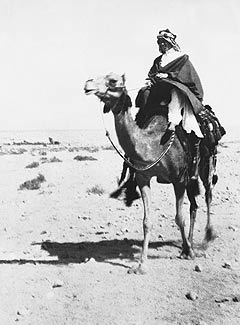Battle of Aqaba
| Battle of Aqaba | |||||||
|---|---|---|---|---|---|---|---|
| Part of the Arab Revolt on the Middle Eastern theatre of the First World War | |||||||
 Thomas Edward Lawrence — a.k.a. Lawrence of Arabia. |
|||||||
|
|||||||
| Belligerents | |||||||
|
|
|
||||||
| Commanders and leaders | |||||||
|
|
|||||||
| Strength | |||||||
| 5,000 men assistance from British naval forces |
300 men (garrison); one infantry battalion (approximately 450 men) | ||||||
| Casualties and losses | |||||||
| 2 killed, ? wounded | 300 killed after surrender 300 prisoners |
||||||
The Battle of Aqaba (6 July 1917) was fought for the Red Sea port of Aqaba (now in Jordan). The attacking forces of the Arab Revolt, led by Auda ibu Tayi and advised by T. E. Lawrence ("Lawrence of Arabia"), were victorious over the Ottoman defenders.
Following an unsuccessful attack on Medina, forces of the Arab Revolt under Emir Faisal I were on the defensive against the Ottomans (or Turks). In the spring of 1917, Arab forces moved north to seize the Red Sea ports of Yenbo and Wejh, allowing them to regain the initiative, but neither the Arabs nor their British allies could agree on a subsequent plan of action. The Arabs began a series of attacks on the Hejaz Railway, and contemplated another campaign against Medina, but with British troops stationary in front of Gaza, it seemed they were not in a position to succeed. The Ottoman government had sent Arab divisions of its army, which held many pro-Revolt units, to the front lines, depriving Faisal and his allies of much-needed reinforcements.
Lawrence, sent by General Archibald Murray, commander of the Egyptian Expeditionary Force, to act as a military adviser to Faisal, convinced the latter to attack Aqaba. Aqaba was a Turkish-garrisoned port in Jordan, which would threaten British forces operating in Palestine; the Turks had also used it as a base during their First Suez Offensive on the Suez Canal in 1915. It was also suggested by Faisal that the port be taken as a means for the British to supply his Arab forces as they moved further north. Though he did not take part in the attack itself (his cousin Sherif Nasir rode along as the leader of his forces), Faisal lent forty of his men to Lawrence. Lawrence also met with Auda ibu Tayi, leader of the northern Howeitat tribe of Bedouin, who agreed to lend himself and a large number of his men to the expedition. Lawrence informed his British colleagues of the planned expedition, but they apparently did not take him seriously, expecting it to fail.
...
Wikipedia
